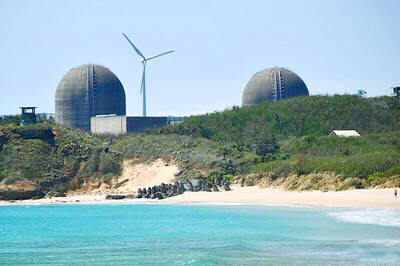Deep in the heart of Taipei beats a passion for Argentine tango. This is not the arched back, straight-line tango of ballroom dancing. Argentine tango is an up close, cheek to cheek, feet and legs brushing, intimate conversation between dancers.
Argentine tango is also addictive, or at least that is the impression that two well-known fans who are involved in putting on a “Milonga” (樂舞會), or tango dance party, at Riverside Live House (河岸留言西門紅樓展演館) tomorrow night give.
Stacy Jou (周思齊) has been teaching tango for about 10 years and cofounded Tanguisimo (探戈藝文沙龍), a dance studio on Zhongxiao East Road (忠孝東路). She is also a key member of the Taipei Tango Association.
“Most of our students are normal — office ladies, 25 to 45, but some are in high school and college. There are also people in their 60s,” she said. “Tango is for every age. You don’t have to be young to dance it; you don’t need to have a dance background. Most students start from zero.”
“Argentine tango you can do in a much smaller space. You do it in an enclosed space; it’s much different than ballroom tango,” she said.
In addition to offering lessons, for the past nine years the association has hosted twice-weekly tango parties and sponsors an annual weeklong tango festival in September that attracts hundreds of dancers from around Asia, Europe and the Americas.
The association has teamed up with club owner Geddy Lin (林正如), who opened Riverside Live House in Ximenting’s Red House Theater (西門紅樓) last fall, to host tomorrow night’s Milonga Tango Party.
But you don’t have to want to dance to appreciate Argentine tango. The music is enjoyable and there are enough musicians in Taiwan who like to play tango music that they have been able to form several tango “orchestras.”
Yvonne Peng (彭靖惠) sings with two of the groups. She was a jazz singer and had recorded four albums before her growing passion for tango — both the music and the dancing — took her in a different direction.
“The albums were all popular music or jazz. But now I’m really interested in tango. I went to Argentina for three months and now I’m teaching [tango] in the studio,” she said.
The passion Peng feels for tango was evident as she animatedly gave a rundown of the groups that will play tomorrow night and their different styles of tango music.
The iTango Orchestra plays traditional music, meaning music from what is called the golden era of tango (1920 to 1950). It has two violinists, two bandoneon (a concertina-like instrument) players, a pianist, bass player and two singers, one of whom is Peng.
Tango Negro only plays Piazzolla music, which dates from after 1955 and is called “tango’s dark era,” in reference to the Argentine politics of that time.
“Piazzolla is very deep, very depressing. Usually we don’t dance to it,” Peng said.
She also sings with Fusion Blanca, which plays “new tango music.” In addition to the piano and bandoneon, there are two guitarists and a
rhythm section.
“We have new songs. We arranged some very famous Chinese songs from the Shanghai era and we modernized them by adding electronic music,” she said.
While Lin, a musician himself, has become famous for sponsoring live rock and indie music events, he was eager to jump on the tango bandwagon, Peng and Jou said.
“He said ‘why don’t we do something since we have so many great musicians?’” Peng said.
“I think he’s quite touched by Yvonne,” Jou said. “She was a jazz singer but now she’s entranced by tango. He used to be a rocker but now he’s interested [in tango] as well.”
He’s also going all out to help create the right atmosphere for a Milonga.
“Riverside Live House is in a beautiful, historic building so it will be really cool to dance there. We will have thousands of roses and [the venue will be candlelit] so it will be very romantic to dance that night,” Milonga project manger Littlesocks Wu (吳思樺) said, adding that 700 people could be accommodated by opening an annex room and the second-floor balcony.
“We also have a blog [milonga.pixnet.net/blog] with all the information about the party, with tango songs and band demos,” she said.
Members of the Taipei Tango Association will be giving exhibition dances at the party as well as offering basic lessons to anyone who wants to give tango a try.
“We’ll teach very simple steps so they can dance that night,” Yvonne said.
Those who attend the party will also be able to take one free lesson at a later date from the Taipei Tango Association.
After talking with Peng and Jou, however, it sounds like the Milonga tickets should come with a warning label that Argentine tango can be addictive — and could change your life.

Behind a car repair business on a nondescript Thai street are the cherished pets of a rising TikTok animal influencer: two lions and a 200-kilogram lion-tiger hybrid called “Big George.” Lion ownership is legal in Thailand, and Tharnuwarht Plengkemratch is an enthusiastic advocate, posting updates on his feline companions to nearly three million followers. “They’re playful and affectionate, just like dogs or cats,” he said from inside their cage complex at his home in the northern city of Chiang Mai. Thailand’s captive lion population has exploded in recent years, with nearly 500 registered in zoos, breeding farms, petting cafes and homes. Experts warn the

No one saw it coming. Everyone — including the Chinese Nationalist Party (KMT) — expected at least some of the recall campaigns against 24 of its lawmakers and Hsinchu Mayor Ann Kao (高虹安) to succeed. Underground gamblers reportedly expected between five and eight lawmakers to lose their jobs. All of this analysis made sense, but contained a fatal flaw. The record of the recall campaigns, the collapse of the KMT-led recalls, and polling data all pointed to enthusiastic high turnout in support of the recall campaigns, and that those against the recalls were unenthusiastic and far less likely to vote. That

A couple of weeks ago the parties aligned with the People’s Republic of China (PRC), the Chinese Nationalist Party (KMT) and the Taiwan People’s Party (TPP), voted in the legislature to eliminate the subsidy that enables Taiwan Power Co (Taipower) to keep up with its burgeoning debt, and instead pay for universal cash handouts worth NT$10,000. The subsidy would have been NT$100 billion, while the cash handout had a budget of NT$235 billion. The bill mandates that the cash payments must be completed by Oct. 31 of this year. The changes were part of the overall NT$545 billion budget approved

The unexpected collapse of the recall campaigns is being viewed through many lenses, most of them skewed and self-absorbed. The international media unsurprisingly focuses on what they perceive as the message that Taiwanese voters were sending in the failure of the mass recall, especially to China, the US and to friendly Western nations. This made some sense prior to early last month. One of the main arguments used by recall campaigners for recalling Chinese Nationalist Party (KMT) lawmakers was that they were too pro-China, and by extension not to be trusted with defending the nation. Also by extension, that argument could be